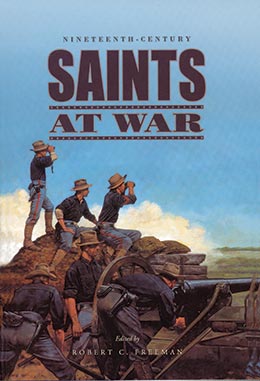Introduction to the Utah War
Sherman L. Fleek
“Introduction to the Utah War,” in Nineteenth-Century Saints at War, ed. Robert C. Freeman (Provo, UT: Religious Studies Center, Brigham Young University, 2006), 77–79.
“Wounded, none; killed, none; fooled, everybody.”
—Captain Jesse Gove, 10th U.S. Infantry, regarding the Utah War
Known popularly among students of U.S. history and Latter-day Saints as Buchanan’s Blunder, the Mormon War, Johnston’s Army, or the Utah Expedition, this conflict is perhaps more correctly called the Utah War of 1857–58. Prior to the onslaught of the American Civil War (1861–65), the federal government and the Latter-day Saints of Utah Territory locked horns in a political, diplomatic, and legal struggle beginning in the early 1850s, which culminated in a military showdown in the fall of 1857. Though no one died in a traditional armed battle, the Utah War was not bloodless—dozens of innocent people loss their lives through indirect forces caused by the Utah War.
From the time Utah became an official federal territory in 1850, a conflict grew between the Saints and the government’s appointed officials. To most Americans, the Mormons of the Great Basin were a troublesome lot—strange, fanatical, heretical, and too far outside the mainstream of nineteenth-century America. The Saints, in contrast, felt betrayed and persecuted by their fellow Americans and saw themselves as victims of religious persecution in the land of liberty. These attitudes and differences lay at the core of the conflict and had earlier emerged in the violence of “Bleeding Kansas” and the clamor for states’ rights and popular sovereignty. The war in Utah may not have been a contest by a more traditional or classical definition, but to the Saints it was a war they were willing to fight if necessary.
After years of receiving official reports, letters, newspaper accounts, and direct testimony accusing Latter-day Saint leaders of sedition and religious tyranny, the federal government demanded Brigham Young’s replacement as territorial governor and the establishment of a less “theocratic” government in this wayward territory. President James Buchanan ordered a military force to escort the new federal officials and to establish and enforce federal law. The war of words and attitudes nearly erupted into combat as Latter-day Saint militia destroyed provisions and captured army stock—acts of open rebellion against federal authority. Not willing to submit without a demonstration of defiance, Brigham Young essentially waved his clenched fist at Uncle Sam but simultaneously sent messengers to negotiate a peaceful arrangement in Washington. The U.S. government had no pretense or anticipation of actual hostilities as the army advanced toward Utah, and it was caught unaware, a dismal showing for the professional regular army. Yet near an oasis along the southern migration route in southern Utah, hysterical Mormon militia and others decided on a rash and dreadful course at Mountain Meadows that culminated in a massacre that has haunted the Church ever since.
By 1858 the adversaries of the Saints saw the foolishness of civil war and negotiated peace and a pardon. For the next three years, an occupying force based in Utah caused few actual problems but incensed the Saints. When the Civil War began in 1861, the regular army closed its largest post in the West and returned to enter the bloodbath in the East.
The Utah War has great significance for Americans as perhaps the first armed contest between a U.S. territory and federal authority. The war represents the largest military operation between the Mexican War and the Civil War; during the Utah War a fourth of the regular army was stationed in Utah.
